These 10 neighborhoods are the ones that most interest people moving to or investing in Puerto Armuelles, Panama.
In the near future, we will add at least 2 photos for each neighborhood on that page. I first need to format the photos to fit on the page property.
However, I can share photos of some of Puerto Armuelles' neighborhoods below.
View from San Vicente towards downtown Puerto Armuelles
That's all. Only wanted to announce the new page, photos of Puerto Armuelles, Panama.
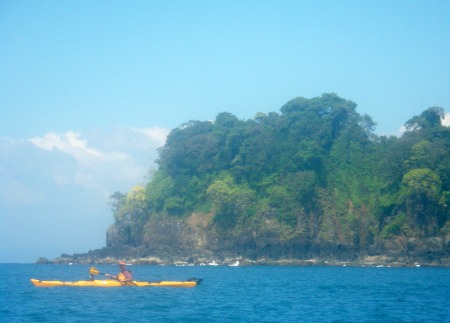
I waited until middle age to buy a sea kayak.
I often paddled directly from my summer home on Lake Superior. I also enjoyed multiple trips in exotic places around the world with my wife.
One of the things which really excited me about living in Panama was the prospect of exploring its coast line by sea kayak. I imported 3 boats from the States, along with paddles, spray skirts and camping gear.
Anyone who comes to visit us, as well as local friends, are dragged out for a trip.
My favourite area is the Boca Chica Islands south of David. I have kayaked to them from Puerto Armuelles. But usually we make the two hour drive from Puerto to Boca Chica for the put in.
From there we paddle 5 or 6 days, self supported, and camping on beaches wherever the mood takes us. The outer islands around Isla Parida have the clearest water for snorkeling, but all are beautiful.
The area is has great rocky headlands, separated by lovely sand beaches. Howler monkeys roar from the jungle and the occasional whale or dolphin can be seen in the ocean.
The land on the Pacific side is public property up to 20 meters beyond the high tide mark. When we camp, we usually we have a beach to ourselves. But when others are around, nobody has ever objected to our presence.
We have to carry our own water, about 5 litres per person per day. We often stock up at the home of a local, if we run low.
While most of my beach landings are gentle, I've had to become very adept at surf landings. Tipping a heavily laden boat and swimming it to shore is exhausting and can wreck the gear.
Before taking visitors on long trips, we usually spend a day at my place in Puerto Armuelles to learn how to control a boat in big waves.
That said, I've taken lots of novices to the protected water of the islands with nothing worse than a few bruised egos to report.
Note from Betsy: Robin & I once kayaked in Puerto Armuelles. Click to read about our paddle. It was a blast. I have always wanted to go again, not sure why I haven't made it happen.
Every trip is different; red sunsets, surprise storms, macaws in the trees above our tents, a fisherman with mariscoes (seafood) for sale, and a mango tree at the campsite.
The companionship of course is always great.
Robin Sare

My Spanish ability is particularly maddening because my husband picks up languages so easily.
My husband Reyn's ease of learning Spanish compared to mine was clear early on in our relationship.
Long ago, when we were first dating, we went to Mexico and Guatemala together.
At that time, my husband had never spoken Spanish. I had had plenty of opportunities to speak Spanish prior to our trip.
Before taking our trip to Mexico and Guatemala, I had tried to learn Spanish.
I must admit, I took the class in Spain so I could hang out at the beach and still "be productive." Unfortunately, I did not feel compelled to study. I was satisfied with the appearance of being productive. That was back when I thought being productive was important.
You would think I could speak Spanish by this point, if only alittle bit. And I could. But I was so afraid of getting it wrong that I rarely spoke.
Reyn read a Spanish phrase book on the airplane ride from Seattle to Mexico City.
That was his total Spanish language preparation. He had never taken a class or traveled in a Spanish-speaking country before.
When we arrived in Mexico City, Reyn knew maybe 15 words in Spanish.
But it didn't stop him from immediately chatting with people.
Me? I took so long to carefully construct my perfect Spanish sentence that the person I was going to "chat" with had left before I'd even opened my mouth.
Reyn's Spanish just kept getting better as we traveled.
He continually butchered the Spanish language with everyone he met. We ended up having many wonderful experiences because of his fearless approach to speaking Spanish.
About 6 weeks later, I went back to Seattle. I had to go back to my job.
Reyn stayed in Antiqua, Guatemala. Reyn had decided he loved Spanish and wanted to really learn how to speak it.
Reyn wouldn't take classes at the many Spanish language schools in Antiqua. He said everyone who took those classes spoke English all the time with their classmates. He doubted they learned how to speak Spanish well. Having attended one of those schools in Spain, I would have to agree.
Reyn lived with a local family and hired not one, but two tutors. He studied there for four months. When he came back to the States he listened to Spanish radio, and ordered the El Pais newspaper from Spain.
His Spanish is now excellent. He would say that he still needs to work on it, but everyone compliments his Spanish.
At the end of our trip, I still didn't speak Spanish well.
Since then Reyn and I have traveled in Spain. We even hired Spanish tutors for a few weeks while we were in Granada, Spain.
I had a Spanish breakthrough in Spain. It was not from my tutor, but from a book, Instant Spanish. I write about it here.
I stopped carefully constructing my sentences before I spoke. I just started speaking. Not correctly but I was speaking. And my Spanish finally started to improve more quickly.
I had developed a more fearless approach to speaking Spanish.
Perhaps if I had kept speaking Spanish I would have progressed to speaking well. Instead I didn't speak any significant amount of Spanish for 8 years.
That is when we moved to Panama. One of the reasons we chose Panama is because it is a Spanish speaking country. We both wanted our daughter to learn to speak Spanish well. Also, I didn't want to start fresh learning a whole new language. It had taken me seemingly forever to get a grasp on Spanish.
After living in Panama for 8 years, my Spanish is better, but it is still not good. While we were traveling in Panama and setting up our life in Puerto Armuelles, my Spanish improved alot.
But these days, I spend most of my days immersed in English. I write posts like this one. I talk with my kids and husband, all in English. When I am in Panama I do speak Spanish everyday, but the proportion is low compared to English.
My husband still speaks more Spanish everyday than I do. I mostly stay at home. He has a local crew he works with on various projects, plus he is simply a more social person than I. He always chats with the grocery store cashier and the people he encounters in his day.
I know life will be richer and more fun, if I can speak Spanish better.
The question is how to learn. The method must be fairly easy and not boring. I know I won't do it if it takes too much time or is too hard.
Recently, technology has allowed an explosion of new & effective language tools. Everything from interactive recordings to being able to talk with a native speaker from any country you want.
But which one will make it relatively painless and easy for me? I have no idea.
I have heard good things about many of these new programs and options.
My plan is to test these programs myself. Then I will tell you want I think of them.
That way, maybe you too will find one that works for you.
If you want to check 'em out at the same time, they each have a free version of their program.
For a free trial of Rocket Language in Spanish, click here.
Fluent in 3 months is by Benny the Irish polygot. Click here to get his free "Speak in a Week" Spanish program.
The free 32 page bi-lingual caroling books are now available in Panama City in all:
Felipe Motta, branches, Casita de Navidad, Crepes and Waffles, Wyndham Hotel Albrook, Restaurant Swiss Chalet, 1985, Avatar Restaurant, Rincon Aleman, Café per Due, Grand Deli, Balboa United Church, St Mary’s New York Bagel, among other retailers, schools, and churches
At the end of each performance, the audience will join the choir in the singing of a favorite Christmas carol.
Saturday, December 12 at 6:60
Mirador Del Pacificoat the fish market end of the Cinta Costera
Santa Claus and his helpers from Casita De Navidad will be there to greet children and pose for photos before the event starts.
To reserve a seat, you need to buy a ticket.
It is free - if you are okay seating on the perimeter. You can get candles at the event.
The cost to reserve a seat is $15, Gold $20, and VIP $25. It includes a souvenir candle which will carry your seat number.
All orders of $20 will be delivered to your Panama City home or office along with song books and candles. You must order soon to get the delivery.
The concert is organized by the CanadaPLUS Foundation.
The foundation holds this event to raise money to aid local charities and institutions.
Beneficiaries this year will be Santo Tomas Hospital and Vision of Hope.
Vision of Hope teaches the blind to make jewelry and to become a functioning part of the community. Samples of their work will be on sale at the event.
The five participating choirs this year are:
- Coro De Opera directed by Paola Cuellar
- Kings College, directed by Vanessa Whay
- The G. Harmony quartet directed by Ricardo Gayle
- Coro JP2 Directed by Danny Gonzalez
- Coro Polifonico Universitario “A Viva Voz” from Chiriqui, directed by Wanda Castillo
The CanadaPLUS Foundation is also helping out with these other events.
December 4, 2016 at 6pm. Hosting a choir for the Hospital Del Nino Christmas Tree lighting ceremony. The foundation will also donate candles to over 200 young patients.
December 11, 2016 at 4 pm. The Chiriqui choir will perform in the lobby of The Wyndham Hotel, Albrook Mall.
A few things to do if you are in Panama City in December.
Have you been to International Living's conferences? One on Panama is coming up on Feb 12-14, 2016 in Panama CityFast-Track Panama: Lifestyle And Opportunity Conference
IL states that they will give you all the information you need to decide if Panama is right for you. They even promise to provide valuable contacts to help you make the move to Panama a success.
I have never been to one of International Living's conferences. Although, I do know people who have, and who enjoyed it. I have been told that their conference is not as over the top enthusiast as their written publications can tend to be.
I won't be at their conference this year either. It is happening during my birthday celebrations. We will be luxuriating somewhere in Panama (exact location is not yet known). Who knows, if you are in the country then we could run into each other. It is a remarkably small country. We seem to run into people we know everywhere we go in Panama.
You can get the conference details on their site by clicking here.
I know the conference is happening soon, probably too soon to make plans to attend. But if it looks interesting to you, you may want to sign up for next year's conference. As I said, I have been told good things about it.
In case you are wondering, I want to be clear, I receive no payment from IL if you attend any of their conferences.
When we had just started poking around to find out where we might want to live, we explored International Living's site and publications alot. Yes, we found its prose a little too rosy at times, but it had alot of good information as well.
If you don't know where in world your next adventure will be, International Living's magazine & website can be inspirational. Just make sure you conduct your own research as well.
At the time of this writing, it is only $49 for one year's worth of magazines. You can cancel anytime.
To be completely transparent, if you sign up - & keep signing up - for the magazine, I make a commission. It doesn't increase your cost at all. Regardless, you should only get the magazine if it adds value to your life.
See the image for the dates. I describe each of the 5 holidays below.
There are parades and festivities galore.
Plan for rain though. November is also the last and often the rainiest month of Panama's rainy season.
Also, with the November holidays, followed by Christmas and then New Years, government offices are often closed from November to early January.
Consequently, it is not the best time of year to quickly get any necessary paperwork acted upon by a government office. You may want to wait until mid-January.
I describe the 5 November holidays, in chronological order, below
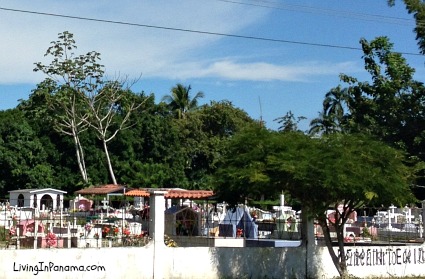
In Panama, the Day of the Dead, or el Dia de los Muertos, is not the huge festive holiday it is in Mexico and some other Latin American countries.
In Mexico, the day of the dead is on November 1 and often extends into the rest of the week.
In Panama, it happens one day later, on November 2nd, and is only celebrated for one day.
It is also officially a dry day. You cannot buy any alcohol in stores or restaurants until after midnight.
On the Day of The Dead, Panamanians visit cemeteries to tidy up and decorate the graves of their loved ones.
Watch out for parades on both Independence & Flag Days in Panama.
This day is also called Separation Day. The day that Panama separated from Colombia.
As you will read, this successful "separation" happened because the US wanted to build the Panama Canal.
In 1903, the US had signed a treaty with Columbia which gave the US the right to build a Canal. The agreement was called the Hay-Herrán Treaty.
Specifically, the treaty granted the US use of the Panama Isthmus to build the canal. In exchange, Colombia would receive financial compensation.
The U.S. Senate ratified the treaty. But the Colombian Senate, fearing a loss of sovereignty, refused.
Understandably, the US was very frustrated over Colombia backing out of the treaty.
In response, President Theodore Roosevelt gave tacit approval to a rebellion by Panamanian nationalists.
These nationalists had recently lost an attempt for Panama independence from Columbia (see the history of their rebellion below).
Given Pres. Roosevelt's "approval", the Panama Canal Company, a French-U.S. corporation formed to build the canal, backed these Panama nationalists.
The Panama Nationalist rebellion started on November 3, 1903.
Unfortunately for Colombia, it had already granted the US management of the railroad on the Panama Isthmus.
Consequently, to help the rebels the US took all the trains off the tracks in Colón. This stranded the Colombian troops that were on their way to crush the insurrection.
The US also sent its warship, the Nashville, to the area which further dissuaded Colombia's army from fighting the rebellion.
It turned out to be a successful and peaceful 3-day rebellion.
Not surprisingly, the brand-new Panama government almost immediately signed a treaty with the US for them to build the canal.
The treaty was negotiated by U.S. Secretary of State John Hay and the owners of the Panama Canal Company.
To be fair, the US didn't create these Panama nationalists. They simply supported them in order to resurrect their Canal deal.
From 1821 - 1903, Panama was part of what was called Gran Colombia. The country of Gran Columbia included modern-day Panama, Colombia, Venezuela, and Ecuador.
In 1821, Panama voluntarily joined Gran Columbia. At the time, it had declared its independence from Spain. They were afraid of Spanish retaliation, so they merged with their stronger neighbor Gran Columbia for protection.
As I mention in my write up of Panama's Independence Day from Spain below, the merger was a mistake. For 80 years Panama experienced neglect and isolation by the Gran Colombian government.
In the mid-1800s, Panama tried and failed 3 times to separate from Colombia.
Then 50 years later, from 1899-1902, a Colombian civil war broke out between conservatives and liberals who wanted to separate from Panama. That war ended only a year before Columbia refused to sign the Canal treaty with the US.
In many ways, the Panama Canal Company didn't need to instigate the rebels. They simply needed to offer aid to the already discontented and defeated liberal leaders of the civil war. And that is what they did.
In exchange, Panama received an initial $10 million, which is the rough equivalent of 285 million in today's dollars.
Then starting 9 years later, Panama received $250,000 annually.
Many Panamanians were not happy with their new leaders signing this deal. They thought of it as an infringement on their country’s new national sovereignty.
So started Panamanians efforts to rescind the treaty.
For decades there were protest and negotiations, with Panamanians demanding control of the Canal.
Finally, as most of you know, Panama gained control over the Panama Canal in December 1999.
What finally happened to cause the US to lose control of the Panama Canal?
It was the pivotal protest on what is now called Martyr's day.
Read my post about Panama's Martyrs Day riot by clicking here.
Most towns in Panama will have a parade to celebrate independence day. (And another on Nov 4th for Flag Day, see below)
The Drumming May Drive You Crazy
For months leading up to these parades, you will hear the school children practicing the snare drum and xylophones. Most schools can only afford those 2 instruments. At the parade, you will see school after school march by playing those instruments, more or less well.
In Puerto Armuelles, we have one school, ESPA, that thankfully has a full band that marches too. They are an excellent band and make good relief to all those xylophones and drums.
In yet another show of sexism in Panama, you will notice that only boys are playing the drums and only girls are playing the xylophones. I have never seen it otherwise.
You will also see police and fire officers marching in full dress uniform.
Like Day of the Dead and most Panama Holidays, you can not buy alcohol from stores and restaurants on Independence Day.
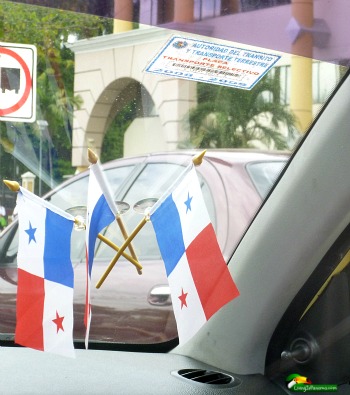
You will see the Panamanian flag waving and hanging everywhere on Flag day.
Flags are displayed on banks, businesses, overpasses, car antenna, anything that can be decorated with a flag.
Originally striped in red and yellow, the Panama flag soon looked like it does today.
Blue - symbolizes purity and honesty
Red - represents authority and law
White - symbolizes peace
Alternative design significance
Other people say the stars on the flag represent the country’s opposing political parties – blue for the conservative party and red for the liberal party – and the white background represents a goal of working together in peace.
1st Cry of Independence from Spain
The uprising of Villa de Los Santos is known as the first cry of independence from Spain. (Primer Grito de Independencia de Espana)
From the early 16th century and into the 19th century, Panama was an important colony for the Spanish Empire.
Panama City's port was particularly useful. The port was ideal for shipping all of the treasures and resources that the Spanish plundered from throughout Latin America.
The Spanish governors were not kind or just to the locals. One day the citizens of the small town of La Villa de Los Santos had had enough.
A Letter is Written To Rebel Simon Bolivar
On November 10, 1821, concerned villagers wrote a letter to Simon Bolivar. Simon Bolivar was an important revolutionary hero throughout Latin America. He was also the President of Gran Colombia. (He was President from 1819 to 1830.)
The letter complained about the Spanish governor and asked Bolivar for revolutionary assistance.
Though not officially the date of independence from Spain, this day pushed the process full-steam ahead.
This day is primarily celebrated in the town of La Villa de Los Santos. They have a parade, of course, which starts on Simón Bolívar Street.

On November 28, 1821, 18 days after Primer Grito de Independencia, the uprising of Villa de Los Santos, an open town meeting occurred in Panama City.
At this historic town meeting, it was decided that Panama would declare independence from the Spanish empire.
Join Gran Columbia
Then they got nervous. Afraid that the Spanish Armada would attack. Panama decided to join its stronger neighbor, Gran Colombia.
This turned out to be a costly decision.
What followed were years of neglect and isolation by the Colombian government.
80 years later, on Nov 6. 1903 Panama also gained independence from Colombia. A day that is celebrated on Nov. 3rd, the day the 3-day rebellion began.
Panama is blessed with gaining its independence from Spain, Colombia, and the US all with a relative lack of violence.
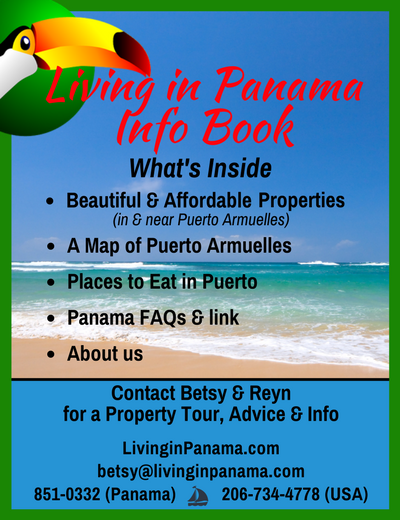
Updated: 2/7/17
And it includes more than properties for sale.
Also, keep in mind, that not all of our properties are listed on-line or in this ebook of our properties.
We save some in reserve for those that make the journey to Puerto Armuelles to see our properties.
Download the listing book here.
Click to explore properties online.
1) Property for Sale in Puerto Armuelles area
2) Info About Puerto Armuelles
3) Places to eat dinner in Puerto Armuelles
4) Link to answers to many FAQs about Panama
5) Information about us at Living in Panama
October 31, 2015
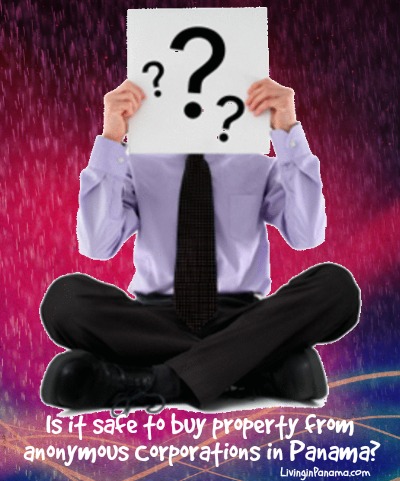
Buying within a Sociedad Anonima shields the party from legal suit.
What this can mean is that the person that the innocent party was negotiating with, the one they met, got to know, and shook hands with, is never seen after the document is signed. That person is was quickly replaced by a powerful Panamanian lawyer, who is the agent or officier for that corporation.
This can be fine, as long as everything goes smoothly. However, if there are some disagreements down the road, or if the intent from the start was to defraud, the innocent expat will discover that he/she is at a tremendous disadvantage, as an individual when facing off against a Panamanian corporation.
Our advice to expats is simply this: Don’t ever sign any documents for purchase or for sale with an anonymous corporation, or with a buyer or seller who has plans to transfer documents to a corporation before all payments have been made, received, and signed that individual.
You do not ever (never, ever) want to find yourself in court, as an individual, facing charges, or trying to seek damages against a corporation.
The person you thought you were doing business with may disappear completely, or they may claim that they have never met you, don’t know what you are talking about, and that everything you are saying is untrue. That person could even sue you for slander for accusing them of something that is absolutely true. Then you’d be involved in two separate lawsuits.
Meanwhile, the seller, or his corporation, may be represented by one of the wealthiest, best-connected lawyers in Panama. A lawyer who may be working overtime to cheat you out of every cent you have invested in Panama. This is not a pleasant prospect.
Never sign a contract with a Panamanian corporation. This is a risk that you do not have to take. Instead, do the following: If there is a property that you are interested in, and it is being held by a Panamanian corporation, have the owner sell it to himself first. Then he can sell it to you.
At least this way you are both being completely transparent, and you face the same risks. This “leveling of the playing field” will keep your business dealings much friendlier. If the seller, or buyer, is unwilling to transfer the property to himself first, he probably wasn’t someone that you should be doing business with. You are better off. Let someone else take the risk.
Many expats are encouraged to establish their own corporations in Panama, even if only to create an umbrella agency for managing their home, their car, any investment properties, etc. The notion is that this is the best way to safeguard oneself, and one's family, from legal repercussions in the event of some unseen “event” in which they might be found legally at fault, and be sued in court. I think that this notion is promoted primarily by Panamanian lawyers, who are always looking for another way to charge expats a couple of grand. Our family does own a couple of corporations in Panama. But we do not see them as the absolute safeguard that others may.
The notion of running one’s entire life in Panama as if you are actually just a mere shareholder in a corporation, instead of an individual, has been touted as the best way to stay out of trouble. This is certainly the idea behind corporations in the US. We all know stories of friends or acquaintances in the US who have lost their shirts investing with an LLC that declared bankruptcy. Meanwhile, the actual people involved in the corporation didn’t lose a penny of their own assets.
Here in Panama, the formation of private corporations has been taken one step further. Unscrupulous US citizens, drug dealers, and smugglers have historically been able to hide the movement of their assets behind a “front” of their various corporations, in an attempt to defraud the Internal Revenue Service.
I cannot say how effective this has been for all investors who follow this practice. However, since Panama is such a small country, and since news travels so quickly here by word of mouth, as well as by internet, it is really quite easy to see which expats are managing their real estate portfolios, in particular, under the name of one or more corporations. There is one investor in our town who has each of his numerous properties registered as a separate corporation. I seriously doubt if this will decrease his tax liability in the US. In fact, I wouldn’t be surprised if any his attempt of his to do so, landed him in jail.
It is no secret that the IRS has recently increased its scrutiny of US expats living in Panama and in other nations considered to be “tax havens”. It is just a matter of time before tax evaders are found out, and brought to justice in the US. In fact, there have been reports of unscrupulous Panamanian lawyers actually turning in their own clients to the IRS for a hefty reward. If part of your interest in investing in Panama is to evade paying your US tax bill, our opinion is that this is a very risky proposition.
For more information on related topics, check out these posts: